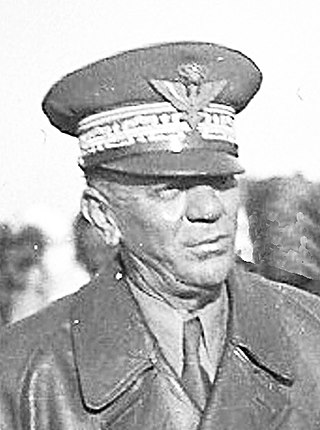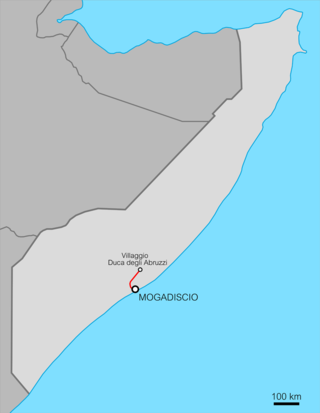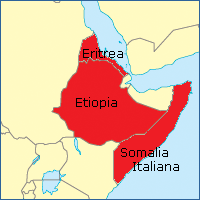
The Italian East African lira was a special banknote circulating in Italian East Africa (Italian : Africa Orientale Italiana, AOI) between 1938 [1] and 1941.

The Italian East African lira was a special banknote circulating in Italian East Africa (Italian : Africa Orientale Italiana, AOI) between 1938 [1] and 1941.
When Fascist Italy imposed the Italian lira in occupied Ethiopia in 1936, it decided upon a rate of 3 lire = 1 thaler. Ethiopians were obliged by law to change their coins and banknotes but considering that the thaler was a silver coin with a value 28 times higher than the lira, they began to hide them to retain the metal value. The Italian government declared this practice illegal, but in 1938 issued a new banknotes "lira AOI" at a better rate of 4.5 lire = 1 thaler for citizens who would willingly exchange their silver coins at the Bank of Italy.
Very few people accepted this and in 1939 they were offered a second possibility at a rate 5 lire = 1 thaler. In Italian Somaliland, the lira was already circulating. In occupied Ethiopia, the lira replaced the Ethiopian thaler (issued by the National Bank of Ethiopia) whilst in Italian Eritrea it replaced the Eritrean tallero, a silver coin minted in Italy. It also briefly replaced the East African shilling in British Somaliland under Italian occupation between 1940 and 1941, when the Italian East African lira was offered at a rate 13 lire = 1 thaler.
The Italian East African lira was seen as a possible bribery, and it was immediately replaced by the East African shilling in 1941, when the United Kingdom gained control of Italy's colonies, at the rate of 1 shilling = 24 lire. The banknotes retired by the British government were later used by the British Army when it occupied Italy between 1943 and 1945, producing with the AM-lira a high inflation in the country.
In 1938, banknotes were issued for use in Italian East Africa in denominations of 50, 100, 500 and 1000 lire. [2] The designs were the same as those used on Italian notes but the colours of the notes were different and they bore an overprint with the words "Serie Speciale Africa Orientale Italiana". A relic of the lira was the use even in the 1960s of the expression "Lix Lira" (=six lira) for 25 cents.

Italian East Africa was an Italian colony in the Horn of Africa. It was formed in 1936 after the Second Italo-Ethiopian War through the merger of Italian Somaliland, Italian Eritrea, and the newly occupied Ethiopian Empire.

The Maria Theresa thaler (MTT) is a silver bullion coin and a type of Conventionsthaler that has been used in world trade continuously since it was first minted in 1741. It is named after Maria Theresa who ruled Austria, Hungary, and Bohemia from 1740 to 1780 and is depicted on the coin.

The birr is the primary unit of currency in Ethiopia. It is subdivided into 100 santims.

The lira was the currency of Italy between 1861 and 2002. It was introduced by the Napoleonic Kingdom of Italy in 1807 at par with the French franc, and was subsequently adopted by the different states that would eventually form the Kingdom of Italy in 1861. It was subdivided into 100 centesimi, which means "hundredths" or "cents". The lira was also the currency of the Albanian Kingdom from 1941 to 1943.

The Somaliland shilling is the official currency of the Republic of Somaliland, an unrecognised sovereign state in the Horn of Africa, recognised internationally as de jure part of Somalia.

The East African shilling was the sterling unit of account in British-controlled areas of East Africa from 1921 until 1969. It was issued by the East African Currency Board. It is also the proposed name for a common currency that the East African Community plans to introduce.

The Somalo was the currency of the Trust Territory of Somaliland administered by Italy between 1950 and 1960. The "Somalo" remained officially in use in the newly created Somali Republic until 1962. It was subdivided into 100 centesimi.

The Somali rupia was the currency in Italian Somaliland from 1909 to 1925. It was subdivided into 100 bese.

The Italian Somaliland lira also called the Somali lira, was a special version of the Italian lira minted in Italian Somaliland between 1925 and 1926.

Banca per l’Africa Orientale (BAO) was an early attempt to establish modern banking in the Horn of Africa at a time when Eritrea and Italian Somaliland were Italian colonies. It closed in 1923.

Luigi Frusci was an Italian military officer in the Italian Royal Army during the Italian conquest of Ethiopia and World War II. He was the last Italian Governor of Eritrea and Amhara.
The Italian guerrilla war in Ethiopia was a conflict fought from the summer of 1941 to the autumn of 1943 by remnants of Italian troops in Ethiopia and Somalia, in a short-lived attempt to re-establish Italian East Africa. The guerrilla campaign was fought following the Italian defeat in the East African Campaign of World War II, while the war was still raging in Northern Africa and Europe.

The Italian African Police, was the provost, and police force of Italian North Africa and Italian East Africa from 1 June 1936 to 1 December 1945.

The Italian colonial empire, also known as the Italian Empire between 1936 and 1941, was founded in Africa in the 19th century and it comprised the colonies, protectorates, concessions and dependencies of the Kingdom of Italy. In Africa, the colonial empire included the territories of present-day Libya, Eritrea, Somalia and Ethiopia ; outside Africa, Italy possessed the Dodecanese Islands, Albania and also had a concession in Tianjin, China.

The Mogadiscio–Villabruzzi Railway is an historical railway system that ran through southern Somalia. It was constructed between 1914 and 1927 by the colonial authorities in Italian Somaliland. The railway connected the capital city Mogadishu with Afgooye, and subsequently with Villaggio Duca degli Abruzzi – usually called "Villabruzzi". The line was later dismantled by British troops during World War II. Plans for re-establishing the railway were made in the 1980s by the Siad Barre administration, but were aborted after the regime's collapse.

The following is a survey of the postage stamps and postal history of Somalia. From the late 1800s to 1960, northwestern present-day Somalia was administered as British Somaliland, while the northeastern, central and southern part of the country were concurrently administered as Italian Somaliland. In 1960, the two territories were unified as the Somali Republic.

Italians of Ethiopia are Ethiopian-born citizens who are fully or partially of Italian descent, whose ancestors were Italians who emigrated to Ethiopia starting in the 19th century during the Italian diaspora, or Italian-born people in Ethiopia.
This is a list of words, terms, concepts, and slogans in the Italian language and Latin language which were specifically used in Fascist Italian monarchy and Italian Social Republic.

Italian Ethiopia, also known as the Italian Empire of Ethiopia, was the territory of the Ethiopian Empire which was occupied by Italy for approximately five years. Italian Ethiopia was not an administrative entity, but the formal name of the former territory of the Ethiopian Empire which now constituted the Governorates of Amhara, Harar, Galla-Sidamo, and Scioa after the establishment of Italian East Africa.

Operations on the Northern front, East Africa, 1940 in the Second World War, were conducted by the British in Sudan and the Armed Forces Command of Italian East Africa in Eritrea and Ethiopia. On 1 June 1940, Amedeo, Duke of Aosta the Viceroy and Governor-General of the Africa Orientale Italiana, commander in chief of the Armed Forces Command of the Royal Italian Army and General of the Air Force, had about 290,476 local and metropolitan troops and by 1 August, mobilisation had increased the number to 371,053 troops. General Archibald Wavell, General Officer Commanding-in-Chief (GOC-in-C) of Middle East Command, had about 86,000 troops at his disposal for Libya, Iraq, Syria, Iran and East Africa. About 36,000 troops were in Egypt and 27,500 men were training in Palestine.
| Preceded by: Eritrean thaler Location: Italian Eritrea Ratio: 1:5 | Currency of Italian East Africa together with the Italian lira (Italian Somaliland, Eritrea, Ethiopia) 1938 – 1941 | Succeeded by: East African shilling Reason: captured by United Kingdom Ratio: 1 shilling = 24 lira |
| Preceded by: Maria Theresa thaler Location: Ethiopia Ratio: 1:5 | ||
| Preceded by: East African shilling Reason: captured by Italy | Currency of British Somaliland together with the Italian lira 1940 – 1941 | |
| Preceded by: Italian lira Reason: British occupation | Currency of Italy together with the Italian lira 1943 – 1945 | Succeeded by: Italian lira Ratio: at par |